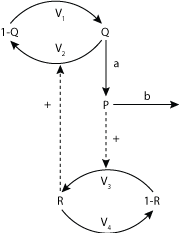Goldbeter,
Model Status
Runs in COR and OpenCell to reproduce published output (figure 3). No scale is mentioned in the paper, so time is scaled arbitrarily in seconds, and variables that might be represented in arbitrary units of mass or force (weight) have been left dimensionless as their normalisation has been mentioned in the paper. The units are consistent throughout.
Model Structure
ABSTRACT: The resolution to lose weight by cognitive restraint of nutritional intake often leads to repeated bouts of weight loss and regain, a phenomenon known as weight cycling or "yo-yo dieting". A simple mathematical model for weight cycling is presented. The model is based on a feedback of psychological nature by which a subject decides to reduce dietary intake once a threshold weight is exceeded. The analysis of the model indicates that sustained oscillations in body weight occur in a parameter range bounded by critical values. Only outside this range can body weight reach a stable steay state. The model provides a theoretical framework that captures key facets of weight cycling and suggests ways to control the phenomenon. The view that weight cycling represents self-sustained oscillations has indeed specific implications. In dymamical terms, to bring weight cycling to an end, parameter values should change in such a way as to induced the transition of body weight from sustained oscillations around an unstable steady state to a stable steady state. Maintaining weight under a critical value should prevent weight cycling and allow body weight to stabilise below the oscillatory range.
A model for the dynamics of human weight cycling, Albert Goldbeter, 2006, Journal of Biosciences, 31, 129-136. PubMed ID: 16595882
 |
| PQR model for weight cycling. |

